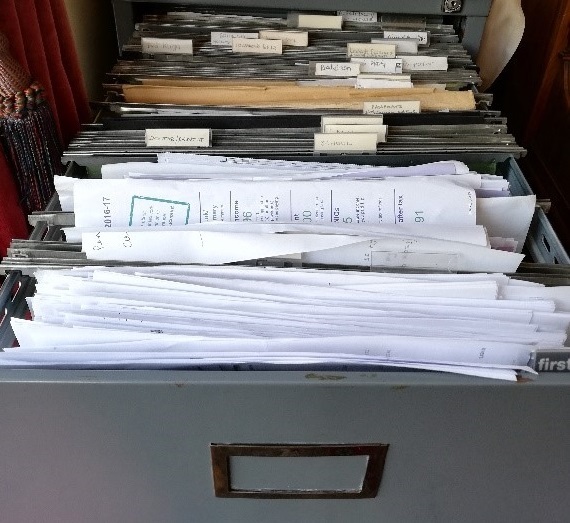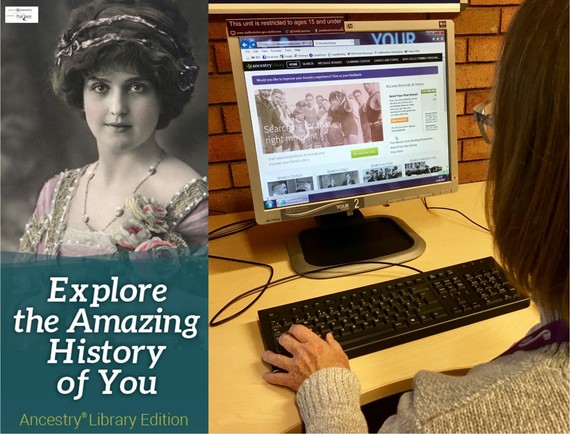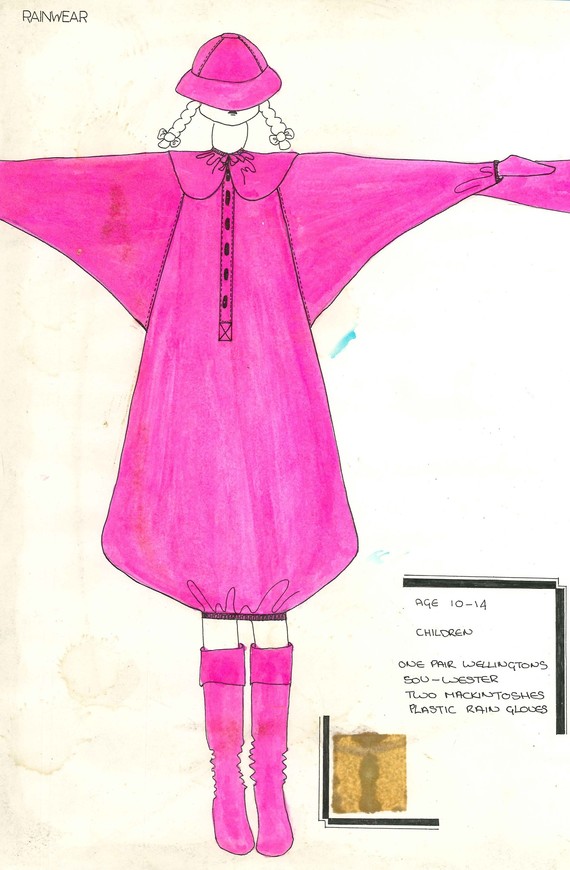 Victory celebrations at English Electric Co., Stafford, 1945 (AE-17.jpg (37/27574)
Join us on Friday 8 May to commemorate the 75th Anniversary of VE Day. You can follow us throughout the day on Twitter @ArchandHeritage, on our Facebook page or via #VEDay75
The photograph shows female employees at the English Electric Company celebrating Victory in Europe in one of the typing pools on the Lichfield Road Site in Stafford. The room has been decorated with bunting and tin hats line the walls. In later years with the introduction of word processors and email, typing pools were phased out. The English Electric Co., was renowned for its electrical products including generators, transformers and switchgear.

This week Senior Conservator Richard Nichols gives some advice on how to deal with those nagging piles of domestic paperwork lurking in boxes and filing cabinets.
Managing your Family Ephemera
In these unprecedented times and while ‘locked down’ we often find ourselves doing those jobs we’ve been meaning to do but never got around to; maybe that deep-clean of the house, tidying the garage or going through paperwork that has been accumulating for ages.
The other day when looking for something in our family filing cabinet at home I remembered that for a long time I had been meaning to weed it and tidy it up! Many of the files were straightforward to deal with; most of our household bills are paid on-line these days so I was able to throw away old hard copy. With Council Tax, TV licence, etc, etc, I was able to get rid of out of date ones and keep only the current year. Our bank statements are all on-line these days too, so I was able to save a lot of space by throwing out about eight years-worth of statements! I usually keep car servicing bills and MOT certificates as a record that will be eventually be passed on with the car when it is sold. I was able to weed ‘bills and guarantees’ and ‘clubs and Societies’, ‘children’s activities’ and ‘newspaper cuttings’. However, you inevitably end up with a lot of material that is a precious part of the families history and culture, this material I decided to take out of the filing cabinet and put into safe archival quality files and folders, then to be boxed and put away for future reminiscences!
Where to get sound advice on storage? That is the question! We have included some tips on how to store and look after your ephemera at home, based on our helpful leaflet which gives guidance on how to handle fragile material.
Our website also has some interesting background information on the work of the Conservators in the Service and about how the Archive Service preserves the County’s archives for future generations.
Caring for your Collections
Most damage to family collections is caused by a combination of factors. These may include; damp, mould, insects, unsuitable packaging and frequent or careless handling. All materials are damaged by light, particularly ultra violet light. Low-grade papers such as newspapers and posters degrade quickly and become brittle particularly if exposed to heat and light. Photographs can be on a support of glass, plastic, paper or metal, which all require special care. Their emulsions are very absorbent and delicate and must not be touched.
For the safe storage of archives a constant temperature and humidity within the range of
13 -19º C and 35-60% Relative Humidity (RH) is recommended (RH is a measure of how damp or dry the air is).
In practical terms this means finding a cool dry place. In most homes particularly modern houses, a cool dry place might be a bedroom, spare room or dining room which has only background heating most of the time. Cellars are prone to high humidity and damp, and roof spaces will often be subject to extreme fluctuation, being cold and damp in the winter and hot and dry in the summer. All items should be kept out of direct sunlight. If items must be displayed then ultra violet filters will help to reduce damage; these can be fitted to windows and lights. Curtains and blinds can also help to reduce exposure.
Things you can do
1. Keep newspaper cuttings separate from all other material.
2. Always remove any rusty paper clips or staples from collections.
3. Store documents and photos flat, this will help prevent distortion.
4. Consider rolling large items around the outside of an archival quality tube.
5. Store items individually in acid free envelopes or folders.
6. Use plastic sleeves made from archival grade polyester. Polyester is ideal for
single unfolded sheets as the item can be viewed without removal from the protective sleeve.
7. Store books in acid free boxes or wrap them in acid free dust jackets to prevent
further damage.
8. Use acid free tissue paper to interleave between pages of volumes with colour plates to prevent off-setting or blocking.
9. Protect prints and drawings in their frames by placing a sheet of UV filter material over the face of the glass (not the drawing).
10. Keep prints, drawings and water colours in individual acid free folders and store them flat in a box.
Things to avoid
1. Don't use self-adhesive photograph albums. Traditional photograph corners or polyester pocket albums are recommended.
2. Don't use newspaper to wrap documents or to line shelves and boxes as it can be highly acidic
3. Don't use ordinary envelopes, files, folders, tissue paper, or corrugated card. These are often of poor and unknown quality.
4. Don't use wooden boxes. The oils and adhesives in these can be acidic.
5. Don't use photographic paper or print boxes, cardboard boxes, shoe boxes etc.
6. Don't use polythene or plastic bags, PVC, plastic envelopes and files. These all
contain plasticizers and chlorine which release harmful chemicals as they degrade.
7. Don't use frames that have poor quality mount board or are backed with wood.
8. Never under any circumstance use any form of pressure sensitive tape, even so-
called safe tape on archival material.
 Basic Preservation at Home
There are things we can all do at home to help preserve our cherished possessions. However, this article can only give general advice on passive preservation. We do not advocate that individuals should undertake any active conservation procedures themselves. If you think that remedial work is required you should seek the advice and guidance of a qualified conservator.
Basic Preservation - Paper
1. Light surface dirt or soiling may be gently removed with a soft (vinyl) pencil eraser. Take extreme care with soft or fragile areas and avoid using an eraser near to any pencil marks, and any other delicate media.
2. Dry mould spores can be removed by lightly brushing off with a soft brush. This must be carried out in a well-ventilated room or outdoors. Care must also be taken not to inhale mould spores. Consider wearing a face mask or dust respirator. Masks must conform to European standard EN 149 category FFP2S. E.g. 3M 8810
3. Never under any circumstances be tempted to use pressure sensitive tapes "sellotape", "scotch tape" etc. as the adhesive used will change chemically and physically and may become impossible to remove at a later date.
4. Do not use water or chemical treatments as these may cause irreversible damage if carried out incorrectly.
5. When handling works of art on paper, you should attempt to handle the paper as little as possible and keep your fingers away from the image.
6. Pastel and charcoal drawings need extra care, as they will smudge with the slightest friction. Polyester film is not suitable for the storage of these or of water colours because a static charge can be created which would lift-off the media.
7. Newspapers are best stored flat to avoid the repeated opening and closing of folds, i.e. they should not be folded except for the single centre fold. They can be gently opened out in separate stages:
• Open the first fold and place between sheets of clean dry blotting paper then put under light but firm pressure for at least 24 hours.
• Repeat this process for the second fold and leave for 24 hours.
• Repeat throughout the paper until all pages are relaxed and flattened. The newspaper should then be stored either in a polyester sleeve or an acid free paper folder.
8. The "four flap folder" is recommended as a safe and versatile storage device that is easy to make, using acid free manilla or MicroChamber®.
Basic Preservation - Photographs
1. Gloves should always be worn when handling photographs. Grease and acids from our hands can be absorbed into the emulsion, which is impossible to remove and will cause tarnishing.
2. Pencil should be used for identifying your photographs. Pencil is graphite, which is chemically stable and will not alter over time, ball point pen, fibre tip and other inks can fade or change chemically.
3. Photographs may be cleaned by the use of a very soft artist's brush or, preferably a puffer similar to those used to clean computer equipment. This will remove loose dirt or dust, but care must be taken not to use anything stiffer as it may scratch the surface of the emulsion.
4. The best possible preservation care for any photograph is to take a good quality copy printed onto archival quality paper. The original should then be packaged and stored in Silversafe® paper under ideal conditions.
Basic Preservation - Volumes
1. Good handling and storage are the best methods we can employ to prevent damage. Books are designed as mechanical objects, and as such they all have the potential to break down with wear and tear.
2. Never force open the cover of a volume if there is any resistance, many books may not open beyond 90 degrees if the structure is particularly stiff.
3. Never extract a volume from the shelf by pulling on the top of the spine, grasp the book either side of the spine and pull gently. It may be necessary to push-in the volumes on either side to make this possible.
4. Turn pages with care. This will help to avoid tearing.
5. If pages are falling out of a book due to the binding having broken down, try to keep them in their original order.
6. Never use any type of pressure sensitive tape to repair tears.
7. Large volumes are best stored flat to prevent any strain on the binding.
8. Loose or detached boards can be held in place by wrapping the volume with a clean dry linen wrap.
9. Silversafe® or Photon® / MicroChamber®/ acid free paper can be used for interleaving coloured or heavily printed pages to prevent of-setting.
10. Books can be stored in archival boxes for protection.

How do we conserve the fragile and unique documents and books in the Staffordshire Archive collections? Watch Archives and Heritage conservator Cara making repairs to the will of Alice Perkyns on our YouTube channel here
 Ancestry Library Edition - Now available at home!
We are delighted to announce that #Staffordshire Library members can now access Ancestry Library Edition at home, thanks to Proquest and Ancestry UK, until the end of May!
To access the site you need to log in to your Library account here You then need to make sure you are in the ‘Account’ section and scroll to the bottom of the page and follow the link where it says ‘Ancestry Access’. We hope you will enjoy this temporary access to the site.
You will need your Library card number and PIN. If you are not a Staffordshire Library member, it is quick and easy to join here
 April showers? What April showers?
We have just officially experienced the sunniest April on record, but it is always a good idea to keep wet weather apparel close at hand at this time of year.
Jane Tomlinson studied art and design at Stafford Art College in The Oval in the 1970s, which included shoe design as well as clothing, and she did some work at Lotus, and working in the design industry all her career. Last year she gave us this collection of coursework, an album of ideas and fabric samples, and final portfolios. This design was for her final coursework, showing rainwear for girls aged 10-14. There are also some photographs of Jane and her friends wearing the actual costumes for the end of year show (7749).
Some new challenges for you to try this week. Good luck!
 Conservation Crossword
Across
2. Our collections are cared for by a professional (11)
3. We probably all need more of this for our collections (7)
8. The Archives and Heritage Service uses this type of tissue paper (4,4)
10. Avoid exposing items to this (6,8)
11. Try to wear these when handling delicate items (6)
12. Damaging form of light invisible to the human eye (5,6)
Down
1. A measurement of the % of moisture in the air (8,7)
4. If a framed item has a backing made of this material it could be damaging (4)
5. A major cause of damage to family collections (7)
6. Avoid using this to wrap or pack items (9)
7. Use this to write on photographs, rather than a pen (6)
9. You can use one of these for lightly cleaning surfaces (5)
Staffordshire Steeple and Tower Challenge - Week 4

 |
|
Fashion Crossword Solutions
Across 6. Bustle; 8. Lotus; 10. Little Black Dress; 11. Mini; 12. Lace
Down 1. Reticule; 2. Cravat 3. Corset
4. Crinoine; 5. New Look 7. Purple;
9. Cardigan
Steeple and Tower Challenge
The answers to Week 3 of the challenge are: Hoar Cross and Butterton (in Mayfield)
|
Our aim is to keep you updated with the latest developments and events. If you do not wish to receive this newsletter please use the 'unsubscribe' button at the bottom of this page.
|